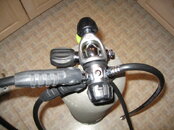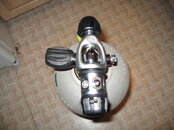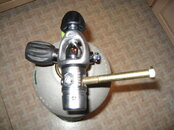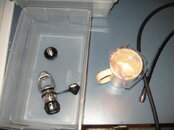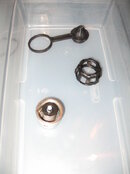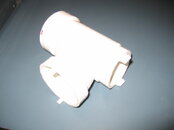R190/R380 Disassembly
1. Remove the mouthpiece zip-tie or locking-clamp
2. Remove the mouthpiece
3. Remove the cover pin on the right-hand-side using your fingernail or a small flathead screwdriver
4. Unscrew the cover using your palm. Sometimes these are on really tight for various reasons. I modified a PVC reducer T...see tool #F
5. Remove the diaphragm retaining washer (toothed washer)
6. Remove the diaphragm
7. Remove the left-hand-side plug with a pair of needle nose pliers (rotate 90deg and pull) and remove the o-ring
8. Remove hose-entry bushing (if it exists)
9. Unscrew the external metal inlet
10. Unscrew the valve adjustment (plastic) part using a screwdriver or tool #c
11. Pull out the internal metal mechanism
12. With a finger on the low-pressure seat, use tool #B to remove the nylon-lock-nut from the poppet assembly. Careful with the alignment washer, metal washer, lever arm and spring
13. Use a pick to remove the LP seat from the poppet
14. OPTIONAL: Remove pin in exhaust port cover using a small screwdriver or pick. Remove cover and push exhaust port. I usually skip these steps...
R190/R380 Cleaning
1. Place all disassembled parts into a tub of 1 part simple green, 20 parts water.
2. Leave for 5-10 minutes depending on how much dirt/grime is on regulator.
3. Use an old tooth brush to scrub biological grime, rinse/repeat in the simple green.
4. Remove parts from solution, rinse thoroughly with water and dry.
R190/R380 Service/Rebuild
Repair Kit:
Item ScubaPro P/N Part McMaster P/N Description
1 01050132, O-Ring AS568A-02-010 Shore A 70, McMaster #9555K11, (For Orifice and LP hose)
2 01050160, O-Ring AS568A-02-016, Shore A 70, McMaster #9555K17, (For Valve body and dummy plug)
3 11108101, Poppet Seat,McMaster #8985K125, High-Strength Weather-Resistant EPDM Rubber 1/16" Thk, 2" W, 36" L, 80A Durometer
4 -----, Punch for poppet seats, McMaster #3424A22, Small-Diameter Hole Punch 9/32" Hole Diameter, Trade Size 11
5 01122101, Lock nut, McMaster #91831A006, 18-8 Stainless Steel Nylon-Insert Hex Locknut 5-40 Thread Size, 1/4" Width, 9/64" Height, packs of 100
6 01075131, Case Pin, -----, I typically reuse these. It's plastic. It's not damaged...
# Christo-Lube MCG-129 lubricant for o-rings.
1. Install lubed 2-016 o-ring (P/N 01050160) on the dummy plug
2. Install new LP seat (made with the punch) in the poppet
3. Install lubed 2-010 o-rings in both the white plastic orifice and the hose
4. Place the poppet seat down on a paper towel, put the spring over the post, and the body over the spring (carefull with the alignment washer outside the assembly)
5. This is tricky...place the lever arm over the post, then the washer over the post, and compress using one hand.
6. With the other hand, install the nylon lock nut using the nut driver.
7. Install the nut so approximately ONE thread of the post shows through (this will get us close to the desired cracking pressure)
8. Now install the assembly back into the reg body
9. Install the lubed 2-016 o-ring on the valve body and screw into the reg body from the outside. Tighten using a wrench.
10. Go ahead and replace the diaphram, retaining washer and cover (no set pin yet!)
11. Leave the dummy plug off and install onto hose with inline adjustment tool
12. Make sure all dummy plugs are in 1st stage, attach rebuilt reg to 1st stage and slowly open k-valve (with your palm over the dummy plug opening).
13. You most likely will hear 2nd stage free-flowing now. With the inline adjustment tool, slowly screw in the orifice (normal threads->right to tighten) until the free-flowing stops
14. Now continue to tighten orifice about 30 degrees (12:00 position to 1:00 position)
15. Now, test the breathing effort on a magnahelic or by feel. You may need to slightly adjust the nylon lock nut with the nut driver to assist dialing in a breathing resistance.
16. When you're satisfied, reinstall the dummy plug, and (turn off the air first) remove the inline adjustment tool and install reg to hose
17. Don't forget to reinstall the faceplate pin. I usually re-use these, or you can use an old one...not extremely necessary, but useful if your faceplate is loose...




